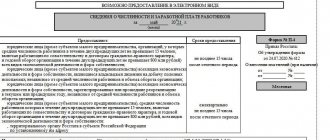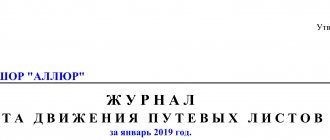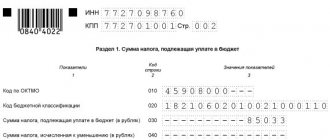Changes in travel documents in 2021
The main innovation is the emergence of a requirement to provide more detailed information about the owners of operated vehicles. If the owner is an individual entrepreneur, then he must additionally register the OGRI in the form; legal entities must indicate the OGRN. The list of required details in the document template has been updated:
- the 2021 waybill must begin with the name of the form, the serial number assigned to it (taking into account the chronology of registration) and the date of issue;
- the validity period of the completed and signed document (the maximum period is limited to one month);
- in the information block identifying the owner of the car, the OGRN number (or OGRIP) must now be additionally indicated;
- information about the driver authorized to drive a specific vehicle and his driver’s license;
- the waybill must reflect data on the registration number of the car, the exact date (down to the indication of hours and minutes) of the last pre-trip inspection.
The requirements for reflecting odometer data in documents before and after field work, the start and end times of the voyage, and the affixing of medical examination notes remained unchanged. At the final stage, the form is signed by the responsible employee. New waybills in 2021 must contain a signature with a transcript of the official responsible for carrying out the technical inspection. The form is endowed with legal force through its signing by the dispatcher, who was charged with the responsibility for preparing this type of documentation, and by the head of the enterprise. Printing is no longer a mandatory attribute.
Column “Transportation information”
According to Law No. 259-FZ, there are three types of transportation that are allowed to be specified in the document:
- Constant travel.
- Routes according to orders.
- Trips involving a passenger taxi.
According to the same regulatory act, there may be more types of transportation of people, cargo, and luggage. These include:
- Transportation within the city.
- Traveling between cities and towns along a route whose distance does not exceed 50 km.
- Intercity routes between cities and towns over a distance of over 50 km.
- International transportation with travel abroad.
Firms developing an individual document form should add the recommended column to the waybill and fill it out specifying the two types of transportation.
Waybill: form and filling it out
A separate waybill form is drawn up for each vehicle in use. The validity period of the document is legally limited. The order of the Ministry of Transport established a range from one day to one month. When several drivers work in shifts on one vehicle, it is allowed to draw up several vouchers (according to the number of drivers) for this vehicle.
The forms differ according to the type of vehicle being used:
- truck waybill;
- for passenger cars;
- trams;
- special transport;
- buses;
- passenger taxis.
Data on odometer readings are entered into the document not by the driver himself, but by an official authorized by the head of the enterprise. Signatures of responsible persons are affixed with the obligatory explanation of surnames and initials. Instead of handwritten signatures, stamps can be used to certify information in a document. An individual entrepreneur is vested with the authority to independently certify odometer readings only if he performs the duties of a driver.
When compiling several waybills for one car at once, the odometer indicator is entered as follows:
- when leaving the parking lot, the data is entered into the waybill of the passenger car (or other vehicle) issued to the driver who made the first trip;
- at the end of the trip and the car is returned to its permanent parking place, the data from the odometer is entered into the form of the driver who was the last to arrive.
All waybills compiled since December (2018 is fully subject to the updated standards; in 2021, the changes affected only part of December) must be in a single copy. The completed forms are issued against signature to the responsible driver. The document is returned when it is closed.
The accounting department recognizes the trip as valid if it contains a report on checking the technical condition of the car before departure. Inspection can only be carried out by a person certified by the transport inspection. Notes on travel sheets (the form can be downloaded below) must contain the following information:
- whether the vehicle and its technical components are in good working order;
- is travel allowed after inspection or not;
- signature of the mechanic responsible for the inspection;
- decoding of the name of the verifying person;
- time and exact date of the inspection.
The norm is relevant if a waybill is drawn up for a truck, passenger vehicle, or passenger car. The validity of the mechanic's and medical officer's records expires after the expiration of the period for which the voucher was issued. If there is no mechanic on staff, the enterprise must enter into an agreement for regular inspections with a specialized technical center.
The form of a waybill for a passenger car and other type of vehicle can be issued for 1 trip, for 1 day or for a month at once. Extension of the validity period of a signed form is not permitted. All issued vouchers must be registered in a special journal (it can be maintained in electronic format).
Specific Features
As in previous years, the form of the waybill is published by the Ministry of Transport as recommended, but not mandatory for use. The Ministry of Transport introduced changes to the procedure for filling out waybills by order No. 17 dated January 18, 2017. Now they must reflect information about pre-trip control of the condition of vehicles. This is required by safety rules (clause 29 of Order No. 7 of the Ministry of Transport of Russia dated January 15, 2014).
This change is key in 2021. It is clear that previously all companies that provide transport services were ordered to check the technical condition of the vehicle immediately before it was sent on a flight. The difference between the previous and current requirements comes down to the fact that in 2021 it is necessary to reflect information about the serviceability of a car or truck on the waybill twice. This is largely explained by statistics on the number of accidents for 2021, according to which the cause of accidents was a malfunction of the vehicle.
Here it would not be out of place to say that a large number of accidents are caused by the unsatisfactory physical condition of the drivers themselves. According to independent data, about 16% of all road tragedies occurred because the driver fell asleep at the wheel or was intoxicated.
(this is what the front side of the waybill form looks like, no longer suitable for use)
The Ministry of Transport has worked on the mistakes and, for its part, ordered companies to more carefully monitor the condition of cars and drivers, making a move towards a more thorough pre-trip inspection of everything possible. Let's look at the document form that you should use now:
We draw your attention to the right side of the form, where it says about pre-trip control. If we talk about the legal side of the issue, then previously the mechanic had the right (theoretically) to mark the serviceability of the vehicle both before sending the car on a trip and after it. Now the form requires the indication of marks before and after the flight.
Moreover, the mechanic should not remain “faceless”. The Ministry of Transport requires that the initials of the specialist who gives permission to use the machine be clearly and clearly stated. According to unofficial statistics, about a third of all cars and trucks in our country set off on the road without a license due to non-compliance with proper safety requirements.
We talked with our client to find out how demanding the management of their company is regarding the pre-trip inspection of a vehicle:
“Now we have begun to monitor the cars more closely. When the first frosts arrived at the end of October 2021, ice formed on the roads. We provide transportation for staff from the metro to the office. God probably saved us when we almost crashed into a traffic light. The fact is that our driver and the mechanic agreed to postpone replacing the brake pads to a later date.
As a result, the brakes did not work correctly and our car began to skid. There were a lot of proceedings on this matter. We settled on the fact that the mechanic and driver were reprimanded. It’s good that we haven’t had any more incidents since then.”
We are sure that such incidents occur very often in our country. Perhaps we all need to be happy that the solution to this problem has been taken up at the state level.
An accountant or logistician now does not have to download the form, fill it out in Word, print it out and give it to officials for signature. In cloud 1C you can already find the required document form and easily fill out the necessary lines.
It should be noted that, according to authoritative legal sources, the waybill form recommended by the Ministry of Transport is mandatory for use in motor transport companies. In those organizations that do not provide for this type of activity, it is permissible to use forms at your own discretion, but taking into account the basic requirements:
- As we said, the pre-trip inspection information must be included;
- This form must meet the requirements for primary documents, which follows from Part 2 of Art. 9 of the Law of December 6, 2011 No. 402-FZ;
- If the form is different from the one recommended by the Ministry of Transport, then it should be reflected in the accounting policy of the enterprise;
- It must contain details (validity period of the waybill, information about the driver or drivers if the car is driven by several people in turn, information about the fuel to be filled, the route, etc.);
- The organization has the right not to put a stamp on the document. Now this is not an obligation, but a right of a legal entity.
However, we do not see an urgent need to develop the form ourselves, given that a more detailed and guaranteed “safe” form already exists.
Nuances to consider when preparing documents
To justify the costs associated with the movement of vehicles by the enterprise, vouchers must be drawn up in accordance with the requirements of Order of the Ministry of Transport of the Russian Federation No. 368 dated September 11, 2020. Forms issued for road trips must be filled out taking into account:
- Strictly regulated columns: number, name, validity period of the document, information about the owner of the vehicle, including the details “Transportation information”.
- Inclusion of only one driver in the document. If the car is driven by several officials during a route, a waybill must be drawn up for each of them.
- Chronologically correct order of voucher numbers.
- Display each document in a paper or computer journal.
As before, the regulatory document allows enterprises to develop a personal form of vouchers and keep records using it, or use a standard form including columns that are mandatory for the current year.
Voucher without a doctor's note
A document filled out according to the established rules, but without a mark and stamp indicating a completed medical examination, is considered valid. When conducting an on-site or desk audit, tax officials recognize the travel expenses incurred for such a voucher. But the traffic police officers will fine you (comment in part 2 of article 12.31.1 of the Code of Administrative Offenses of the Russian Federation):
- driver - 3,000 rubles;
- manager or head of the transport department - 5,000 rubles;
- legal entity - 30,000 rubles.
If a budget organization uses a false stamp to confirm a driver’s medical examination or illegally violates the established procedure, Article 11.32 of the Code of Administrative Offenses provides for fines:
- per driver - from 1000 to 1500 rubles;
- for the manager or responsible person who allowed the use of a false stamp - from 2000 to 3000 rubles;
- for organization - from 30,000 to 50,000 rubles.
Storage periods and responsibility
Current legislation does not establish precise storage limits for this case. Keep the filed and numbered document in the organization for at least 5 years, as it contains information about the primary document (waybills). Determine by a separate order the person responsible for maintaining and storing the property.
The organization is obliged to ensure the safety of vouchers for a period of 5 years, this is established by order of the Ministry of Transport of Russia dated September 18, 2008 No. 152. The same period is established by Art. 29 of Law No. 402-FZ for primary accounting documents.
Responsibility for the correctness of the compilation and reliability of the specified information lies with the persons who provided this information, as well as the head of the institution. An incorrectly compiled voucher is considered void. Tax authorities will not accept such a document as confirmation of transportation expenses for a car, which threatens to increase the income tax base and penalties.
So, mandatory pre-trip medical examinations are carried out for all vehicle drivers, and mandatory post-trip medical examinations are carried out only for drivers whose work involves transporting passengers or dangerous goods.
Such violations are identified, recorded and examined by representatives of internal affairs bodies (police), including the traffic police (clause 5, part 2 and part 1, article 23.3 of the Administrative Code).
The legislation on administrative offenses provides for liability for violation of rules on cargo transportation. In this sense, individual entrepreneurs are considered on an equal basis with legal entities. The fine for an entrepreneur will be 30 thousand rubles. It is assigned if private entrepreneurs do not undergo a medical examination before or after the relevant trip.
As for the presence of a mechanic, it can be replaced with professional equipment. If the waybills contain pre-trip diagnostic readings certified by a certified person, this is not considered a violation. As a rule, the State Traffic Inspectorate holds individual entrepreneurs or drivers accountable.
List of employees who may be held accountable for such violations:
- the head of the relevant department of the State Traffic Inspectorate;
- deputy chiefs;
- commanders of platoons or detachments of PPS;
- deputy commanders.
Fines imposed by other persons have no legal force. If an individual entrepreneur carries out transportation without any waybills at all, he may be held accountable for illegal cargo transportation. For such a violation, the fines are much higher.
Individual entrepreneurs can be held accountable for violations of cargo transportation rules within a year from the date of issuing the waybill. If, during an inspection by a supervisory authority, a violation of the procedure for document execution within the last year is discovered, then appropriate measures will be applied to it.
Column “Vehicle data”
The details require indicating not only the model, as was previously the case, but also the make of the car, as well as the make of the trailer/semi-trailer, if they are in use. In the same column, the meter readings are specified when the car leaves the parking lot and returns to the parking lot at the end of the shift. The data is recorded by the responsible person appointed by the order, who affixes his signature and initials next to it. If the individual entrepreneur is the driver of the vehicle, a responsible person may not be appointed.
The previous version of the law did not require entering information based on the route to the parking space.
Waybill for vehicles
This is a document for primary accounting that confirms:
- fact of vehicle movement;
- vehicle and fuel maintenance costs;
- the fact that the car is in good condition;
- ownership rights of an organization or individual entrepreneur to a car;
- the driver's right to drive this vehicle.
A budget organization can independently develop a form based on the specifics of its activity. Or use unified forms for types of vehicles, approved by Decree of the State Statistics Committee of November 28, 1997 No. 78. Vouchers should be kept in a special registration journal (using Form 8 or developed independently). Primary records and log books must be stored for at least 5 years (clause 18 of section III of Order No. 152 of the Ministry of Transport of Russia dated September 18, 2008).
Marks on technical control and medical examination
According to the new instructions, responsibility for the serviceability of vehicles lies with the vehicle condition controller - an official appointed by order of the manager. Upon completion of the daily check, he puts an inscription on the document: “Release to the line is allowed.”
After the drivers are examined by the medical staff, marks are given in the following forms: “passed a pre-trip medical examination, cleared to perform labor duties” and “passed a post-trip medical examination.”
Read about the specifics of recording medical examinations at an enterprise in our article: “For whom are medical examinations required? Accounting and reimbursement of expenses.”
Information about the vehicle make and odometer readings
In addition, new mandatory details will appear as part of the vehicle information. Here you will need to additionally indicate the make of the vehicle, and if the vehicle is used with a trailer, then the make of the trailer.
In addition, it is clarified that information about the vehicle includes odometer readings both when the vehicle leaves the parking lot intended for parking upon returning from a trip and the end of the driver’s shift, and when the vehicle enters the parking lot at the end of the shift (working day).









